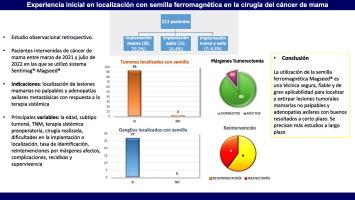Experiencia inicial en localización mamaria y axilar con semilla ferromagnética en la cirugía del cáncer de mama
IF 0.2
Q4 OBSTETRICS & GYNECOLOGY
引用次数: 0
Abstract
Introduction
Currently, there are localization methods with advantages over the wires. Our objective was to analyze the accuracy and safety of the Magseed® ferromagnetic seed for the localization of non-palpable tumors and axillary lymph nodes in breast cancer patients at our center.
Methods
A retrospective observational study from March 2021 to July 2022, which included patients who underwent breast cancer surgery at our institution in whom the Sentimag-Magseed® system (Endomag Ltd.) was used for localization of non-palpable tumors and clip-marked axillary lymph nodes.
Results
Magseed® was used in 111 patients, implanted in the breast in 88 (79.3%), in the axilla in 16 (14.4%), and in both breast and axilla in 7 (6.3%). Tumors, marked lymph nodes, and seeds were successfully excised in all cases. In 2 patients (2%), tumor localization required wire (identification rate (IR): 98%). In one case, there was a failure to implant the seed in the tumor (1%). In the axilla, in 2 cases (7%) the seed was in the periganglionic fat. The lymph node IR was 100%. Ten patients (11%) had positive margins. Eight patients (8%) experienced complications unrelated to seed use. There was no operative mortality and no recurrences.
Conclusions
The use of the Magseed® seed for the localization of non-palpable tumors and axillary lymph nodes is a safe, reliable, and reproducible method. Studies are needed to assess its long-term results.

在乳腺癌手术中使用铁磁种子定位乳腺和腋窝的初步经验
目前,有一些定位方法比有线有优势。我们的目的是分析Magseed®铁磁种子在我们中心乳腺癌患者不可触及肿瘤和腋窝淋巴结定位中的准确性和安全性。方法回顾性观察研究于2021年3月至2022年7月,纳入在我院接受乳腺癌手术的患者,这些患者使用sentimagg - magseed®系统(Endomag Ltd.)定位不可触及的肿瘤和夹标记的腋窝淋巴结。结果111例患者使用smagseed®,88例(79.3%)植入乳房,16例(14.4%)植入腋窝,7例(6.3%)同时植入乳房和腋窝。所有病例均成功切除肿瘤、明显淋巴结和种子。2例(2%)患者肿瘤定位需要钢丝(识别率:98%)。在一个病例中,有一个失败的种子植入肿瘤(1%)。腋窝2例(7%)种子位于神经节周围脂肪。淋巴结IR为100%。10例患者(11%)的切缘呈阳性。8名患者(8%)出现与种子使用无关的并发症。无手术死亡,无复发。结论Magseed®种子用于不可触及肿瘤和腋窝淋巴结的定位是一种安全、可靠、可重复性好的方法。需要进行研究来评估其长期效果。
本文章由计算机程序翻译,如有差异,请以英文原文为准。
求助全文
约1分钟内获得全文
求助全文
来源期刊

Revista de Senologia y Patologia Mamaria
Medicine-Obstetrics and Gynecology
CiteScore
0.30
自引率
0.00%
发文量
74
审稿时长
63 days
 求助内容:
求助内容: 应助结果提醒方式:
应助结果提醒方式:


